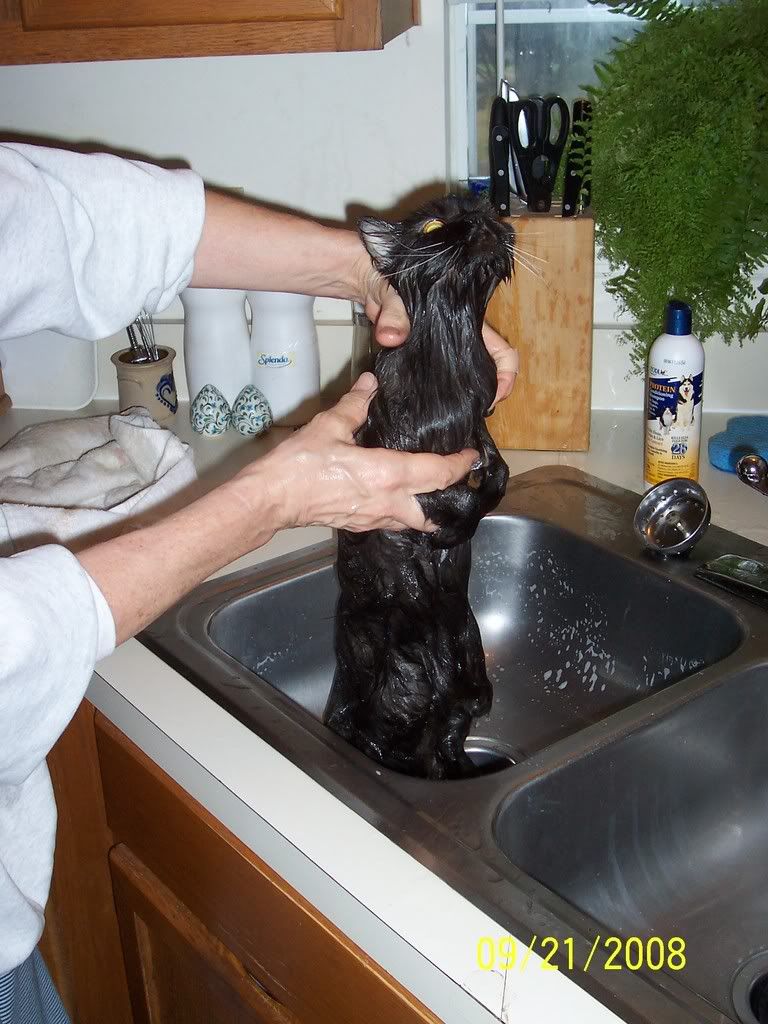src="http://pagead2.googlesyndication.com/pagead/show_ads.js">
•Always carefully read and follow the label instructions of the cat flea medicine before administering to your cat.
•Always check to be sure that the dosage of the cat flea medicine is based upon the correct age and weight for your cat before application.
•Always follow your veterinarian's recommendations when administering cat flea medicine to your cat. If his recommendation conflicts with the label directions, ask for an explanation. And always make sure your veterinarian is aware of any other products you may be using for flea control, including area sprays, shampoos, and powders.
•Products labeled for other types of animals should not be given to your cat. In other words, do not try save money by letting your dog flea medicine do double duty on your cat.
•Be careful using over-the-counter pet store cat flea medicines. If in doubt, check with your veterinarian to determine safety. Cats have been reported to have toxic reactions to flea control products with permethrin or pyrethrin as the active ingredient.
•Wash your hands thoroughly with soap and water after applying cat flea medicines.
•As always, keep cat flea medicines and all petmedicines out of the hands of children.
•And finally, remember that cat flea medicine is just one step in managing the health of your cat. Regular grooming should be a daily part of your cat's life. Using a shedding brush to prevent hair mats and hair balls will help your cat stay healthy and looking good. Follow up with a flea comb to make certain your cat is flea free. These combs have very closely spaced teeth that will gather up the fleas. By quickly pushing the fleas off the comb and into a bowl of water with a dab of ammonia in it will kill them instantly, and prevent the little beasts from hopping back onto your cat. The immediate relief your cat will experience from flea combing will bring him back for more every day. YOU will become his hero.
Cat flea medicine may be the most important product you buy to care for your precious cat. Fleas are not just annoying; they are a real health hazard for your cat as well as any other animal living in your home including yourself. Flea bites are painful and irritating. For cats that are sensitive or flea-allergic, the itching can be quite severe and lead to hair-loss, inflammation and secondary skin infections. Some cats are so hypersensitive to the flea's saliva that they will itch all over from the bite of even a single flea! These prolific pests can also carry worms, that when ingested by your cat can cause serious health problems. A severe infestation of fleas can even lead to a cat's death from blood loss and anemia. Administering cat flea medicine is one of several important steps that all cat owners should take to protect their cat, their family, and their home from fleas and other pests.
Features to Consider in Cat Flea medicine
•Veterinarian recommended – The best place to begin choosing a cat flea medicine is with your veterinarian. He or she will be familiar with issues unique to your cat and the region in which you live that may affect the best choice of cat flea medicine.
•Dosage – Whenever you administer any type of cat flea medicine, be certain that the dosage is appropriate for your animal based upon breed, size, and overall health.
•Effect – You may want to consider a cat flea medicine that is also effective against other pests like mosquitoes and ticks, depending upon where you live and the indoor/outdoor habits of your cat.
•Presentation – Cat flea medicine is available in a large variety of products from oral liquids and pills to topical liquids and shampoos. You will want to consider what will be the easiest form for you to consistently administer.
•Safety – It is important to choose a cat flea medicine that will be safe as well as effective. Always follow the label directions and your veterinarian's recommendations when administering any form of cat flea medication. Never use dog flea medicine on your cat.
•Efficacy – Whatever method you choose to administer cat flea medicine you will want to be sure it is effective. Due to the prolific nature of fleas, half measures may only make the problem worse. It is usually best to use a cat flea medicine that not only kills the adult fleas, but also kills the egg and larval stages of the flea to interrupt the flea life cycle.
•Ingredients – Ask your veterinarian what ingredients in the cat flea medicine will be both effective and safe for your cat. Traditional pesticides contained in insect control products for other animals and the environment can be toxic to cats, so it is best to use a cat flea medicine specifically formulated for cats. Additionally, many natural remedies that rely on aromatic oils are potentially toxic to cats.
•Cost – You will want to consider the cost over the long term when choosing any cat flea medicine. Regardless of where you live, a flea control program for cats should be year around because sporadic flea prevention can lead to flea allergies in cats.
•Guarantee – You may want to consider whether the cat flea medicine you choose comes with a guarantee, and remember that the guarantee will be based upon proper administration of the cat flea medicine.
•Waterproof – Unless your cat lives outdoors or enjoys regular bathes, you probably don't need to choose a cat flea medicine that is waterproof. While it is worth the extra expense with many dogs, you can probably save some money here with your cat.
•Frequency of administration – You will want to consider your cat's lifestyle and how much time you wish to spend grooming your cat in order to decide how frequently you will want to administer your cat flea medicine.
Desirable Features of Cat Flea medicine
•Ease of administration – No one wants to have to wrestle with their cat on a regular basis to administer cat flea medicine.
•Safe – The cat flea medicine you choose should be formulated specifically for cats and administered in the proper dosage for your specific breed, age and size of cat.
•Effective – Depending upon where you live and whether your cat is indoors or outdoors you will want to choose a cat flea medicine that will be effective to provide complete protection for your cat. If in doubt, consult with your veterinarian to determine the type of cat flea medicine that will be most effective for your unique situation.
•Cost – Consistency is the key, so choose a cat flea medicine that you will be able to consistently provide for your cat.
Ideal Choice in Cat Flea medicine
For most of us, a topical cat flea medicine used once per month is the easiest and most cost effective to administer. Some of the top cat flea medicine products on the market include:
•Advantage® - cat flea medicine both repels and kills fleas.
•Frontline Top Spot® - cat flea medicine also repels and kills fleas as well as ticks.
•Frontline Plus® - cat flea medicine repels and kills fleas and ticks like Frontline Top Spot, but is also waterproof.
•Revolution® - cat flea medicine. In addition to killing fleas, this product also prevents heartworm disease, and controls ear mites, hookworms and roundworms.
For severe infestations, the following two cat flea medicine products may be your best choice.
•Capstar® - cat flea medicine. This kills adult fleas very quickly, starting within 30 minutes, and may be useful for particularly sensitive cats that have been unexpectedly exposed to fleas. It is in pill form, and is often used in combination with Program® to help prevent the fleas from returning and prevent eggs from hatching.
•Program® - cat flea medicine. Prevents flea infestation by preventing development of the flea eggs. This is available in monthly injection, tablets and liquid forms for cats. It is often used with Capstar®, which kills adult fleas when there is an active infestation.
Source from www.petproductadvisor.com





